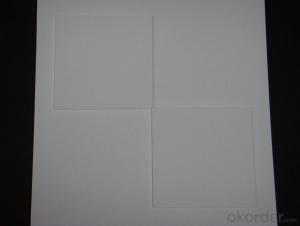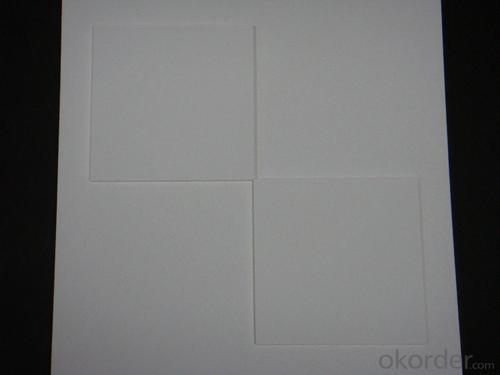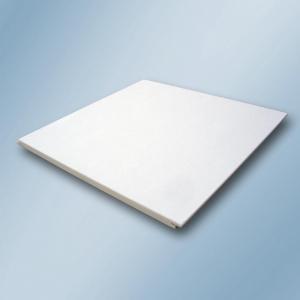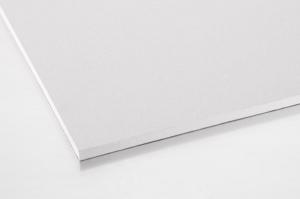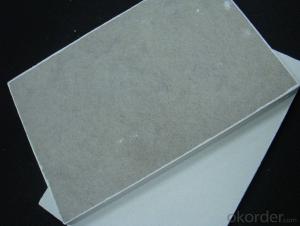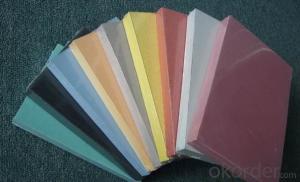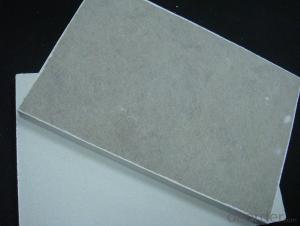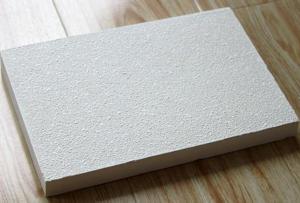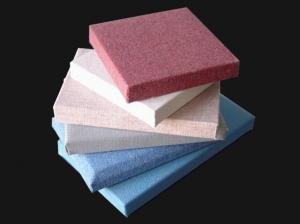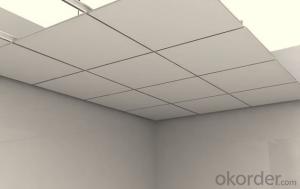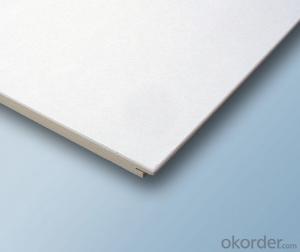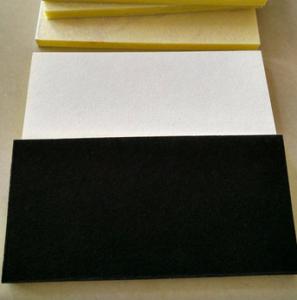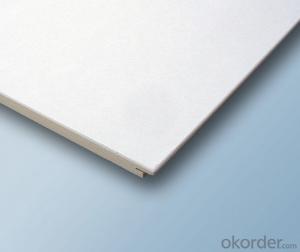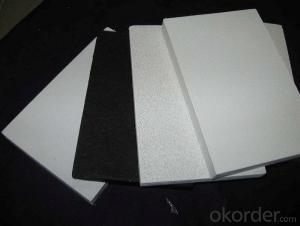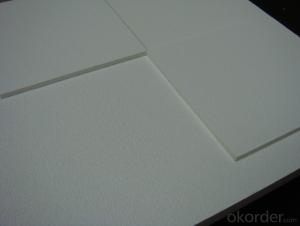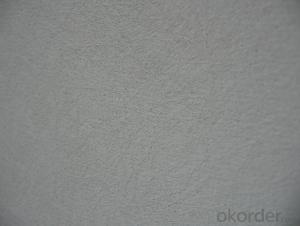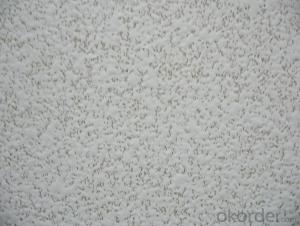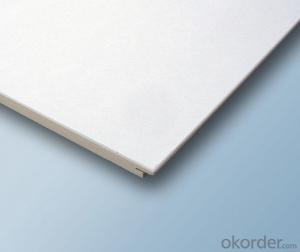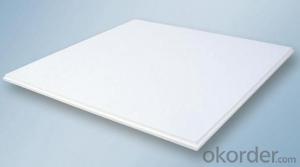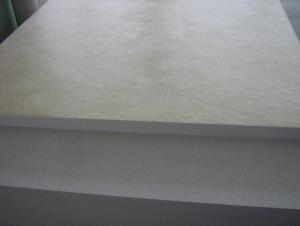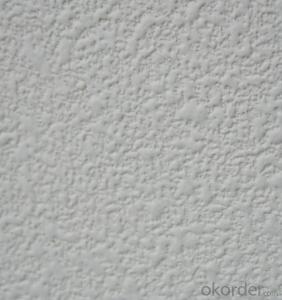Black Fiberglass Ceiling Tiles - Acoustic Fiberglass Ceiling 100k Density
- Loading Port:
- Shanghai
- Payment Terms:
- TT OR LC
- Min Order Qty:
- 3000 m²
- Supply Capability:
- 10000 m²/month
OKorder Service Pledge
OKorder Financial Service
You Might Also Like
Fiberglass Ceiling
The tiles are manufactured from high density fiberglass wool.The visible face has a decorative fiberglass tissue and the back of the tile is covered with normal tissue.The four edges of the tile are sealed and have grooves. It can be jointed together without suspended system. The tiles will cover the suspension system after installation. They are are suitable for loe flap ceiling space and concrete-made, wooded-made or gymsum ceiling.
Installation method:
Use screw to fix the smooth roof. The tiles can be connected after making grooves on each two jointed edges.
Tiles are easy to trim and install
Both inches and metric grids are available
Main Characteristic:
Non-combustible
No sagging,wrapping or delaminating
Green building material
Excellent sound absorption
Application:
Halls,classrooms,offices,shopping centers.etc.
Acoustic fiberglass ceiling contains a better perfomance in tension strong, light weight, so it is easy to trim and install for interior decoration, with T-grids for suspension system or glue, nail or good material could come with fiberglass ceiling baord. Thus an excellent artical work need a high quality acoustic ceiling board, also high quality.
Energysaving is a trend for our 21' era, new product like fiberglass ceiling tile could in place of traditional products one day. Which depends on functional characters: little deflection of geometry dimention, no radiocative property, specific activity of 226Ra: Ira ≤1.0 and specific activity of 226 Ra 232 Th, 40 K: Ir ≤ 1.3. Both products and packages can be recycled.
- Q: Waterproof acceptance how to accept kitchen and toilet waterproof is done?
- Fire-resistant paint, aluminum-plastic board, fire board, and fire-retardant woodworking board,
- Q: Fiberglass sound-absorbing ceiling features
- Substrate: dry glass fiber synthesis, high strength. Surface decoration: acrylic paint non-combustible properties
- Q: the fabric lining my jeep's ceiling is missing in the front of my car. came down in bits and pieces and i wasn't able to reattach it. there's a material underneath that looks something like yellow fiberglass??? is that right? is it safe to be exposed to this? i don't use the car much so i haven't had it fixed yet but i'd like to know what i'm dealing with here. thanks for any help!
- its not fiberglass, its a hard resin foam. Will do no harm, unless you chew it up and swallow it or snort it... But being exposed to it is not bad for your health..
- Q: How to do a good job of tile exhibition hall design
- The slope of some non-stick, because sometimes to win and other brick than the vertical, then you can use stone glue to answer the answer can be. Decoration in some of the shape is posted sandstone what, the end is the use of woodworking board base, and then stone glue to sand
- Q: I live in the basement and the tiles in my drop ceiling are so annoying there the normal whatever material they are and i have dark carpeting and i guess our house sucks because I have to vacuum all the time because ill look down and there will be white specks all over the floor which im guessing is coming from the tiles from when people walk upstairs. So i want to replace them with a material that wont do that.
- Sounds like the tiles are crumbling and need to be stablised. Take out the tiles and give them a coat of a water based glue such as PVA diluted 3 parts water 1 part PVA. Let it dry well and paint with a water based paint to a colour of you choice.The tiles are probably getting damp, this usually causes problems with them but this will fix it for a while.
- Q: Cast-in-place floor (ceiling position) Reinforcement protective layer is not enough, local steel exposed. I intend to use epoxy resin mortar
- If not skilled, epoxy resin mortar is not good to paint. And grass-roots bonding is a problem, the level of skilled workers is also a problem. Suggest, 1, steel rust to be completely, or the same burst open; 2, carbon fiber reinforcement approach, that is, epoxy resin plus fiberglass cloth, professional construction. Quality assurance, the effect is much better than their own configuration of epoxy resin mortar. In addition, crack prevention. This method of handling is a formal approach that can be changed by design. 3, the surface putty putty, it is finished.
- Q: What is the role of chemically tinned magnesium chloride?
- Enhance the conductivity of the solution
- Q: What is the idea of interior design?
- Environmental protection
- Q: Glass fiber plant to waste silk down in our here, this is harmful to our living environment?
- In the past, they are sometimes used to do ceiling cotton, and now have been eliminated. It is because they cause damage to the human respiratory system, so the state put this thing included in the ban on the list.
- Q: But it's fiberglass and needs to be flexible for when it moves. I think actual mirrors will crack and be too heavy. What do I use for the mirrored effect?
- a fabric called mylar. The material most ballons are made from.
Send your message to us
Black Fiberglass Ceiling Tiles - Acoustic Fiberglass Ceiling 100k Density
- Loading Port:
- Shanghai
- Payment Terms:
- TT OR LC
- Min Order Qty:
- 3000 m²
- Supply Capability:
- 10000 m²/month
OKorder Service Pledge
OKorder Financial Service
Similar products
Hot products
Hot Searches
Related keywords
